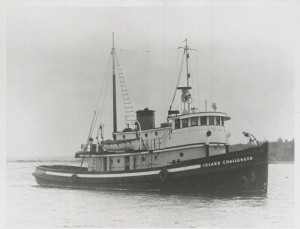
The World War II-era Tugboat, that sank in Gastineau Channel in September of 2015, has been successfully raised and moved, the Coast Guard reported on Tuesday.
The 96-foot tugboat, the “Challenger,” which was originally designated the “TP(tug/passenger)-126,” then after decommissioning, later re-named the Island Challenger,” was shifted to shallower water on Tuesday, the Coast Guard reported. “The lowering tide exposed more freeboard as the keel rested on the bottom. Divers were able to then use de-watering pumps and make necessary patches and repairs” throughout Monday night, USCG Lt. Jennifer Ferreira wrote.
Following the de-watering, “the Brightwater Crane Barge was able to slack the hoisting slings,” and the vessel was able to float on its own. Then, the Tug “Norman O” took the dilapidated “Challenger under “dead ship tow” and transferred the tug to Juneau’s AJ Dock.
The tug will now undergo an assessment to locate any remaining oil and hazardous materials, which the Coast Guard says will “be removed from the vessel and disposed of in accordance with all applicable Federal and State regulations.”

“We are very pleased to see today’s positive results and look forward to continued progress in cleaning the Tug Challenger at the A. J. Dock,” said Cmdr Patrick Hilbert, incident commander. “We could not have had this success without the outstanding cooperation between our contractors and federal, state, local and tribal partners supporting the removal operations.”
The initial operation to remove the tug from the Gastineau Channel was completed on February 5th, then suspended as they awaited four one-ton slings from Seattle. Then on Sunday, February 20th, the operation was re-started and the slow process of bringing the tug to the surface was initiated. The tug was partially hoisted, but the position of the tug as it re-emerged, made it difficult to complete the de-watering and the operation was postponed until Monday. By Tuesday, the “Challenger” was floating on its own.

Built in Wilmington, California in 1944 as one of 43 harbor tugs built on the West Coast for the U.S. Army, the “TP-126” plied the west coast all the way to the Aleutian Chain until it was decommissioned two years later in 1946. She was sold to Island Tug and Barge on Vancouver Island that year, and re-named the “Island Challenger.” It spent the next three decades pulling log rafts and barges as well as performing salvages for that company. When the company was merged with Vancouver Tug, the vessel was re-named again to the “Seaspan Challenger.”
The vessel was sold again in 1982 to a private owner and in 1985, it was moved to Lake Union where it became a floating bed and breakfast. It would remained thus for the next 18 years, until the passing of her owner. In 2002, she was sold once again and made her way back to Alaska under the ownership of Timothy Miles.
In Juneau, after partial refurbishment, the vessel would become the floating music school the “Heartstrings Violin Studio,” until she was sold yet again, this time to R.D. Robinson in 2014. From that time, it lay at anchor in the channel, where it eventually sank in mid-September, 2015. The Coast Guard responded to the scene of the sinking and deployed oil boom and worked to remove fuel and oil from the vessel. Shortly after, parts of the vessel began separating from the boat and could be found on beaches and harbor stalls in Juneau’s two boat harbors. [xyz-ihs snippet=”Adsense-responsive”]
